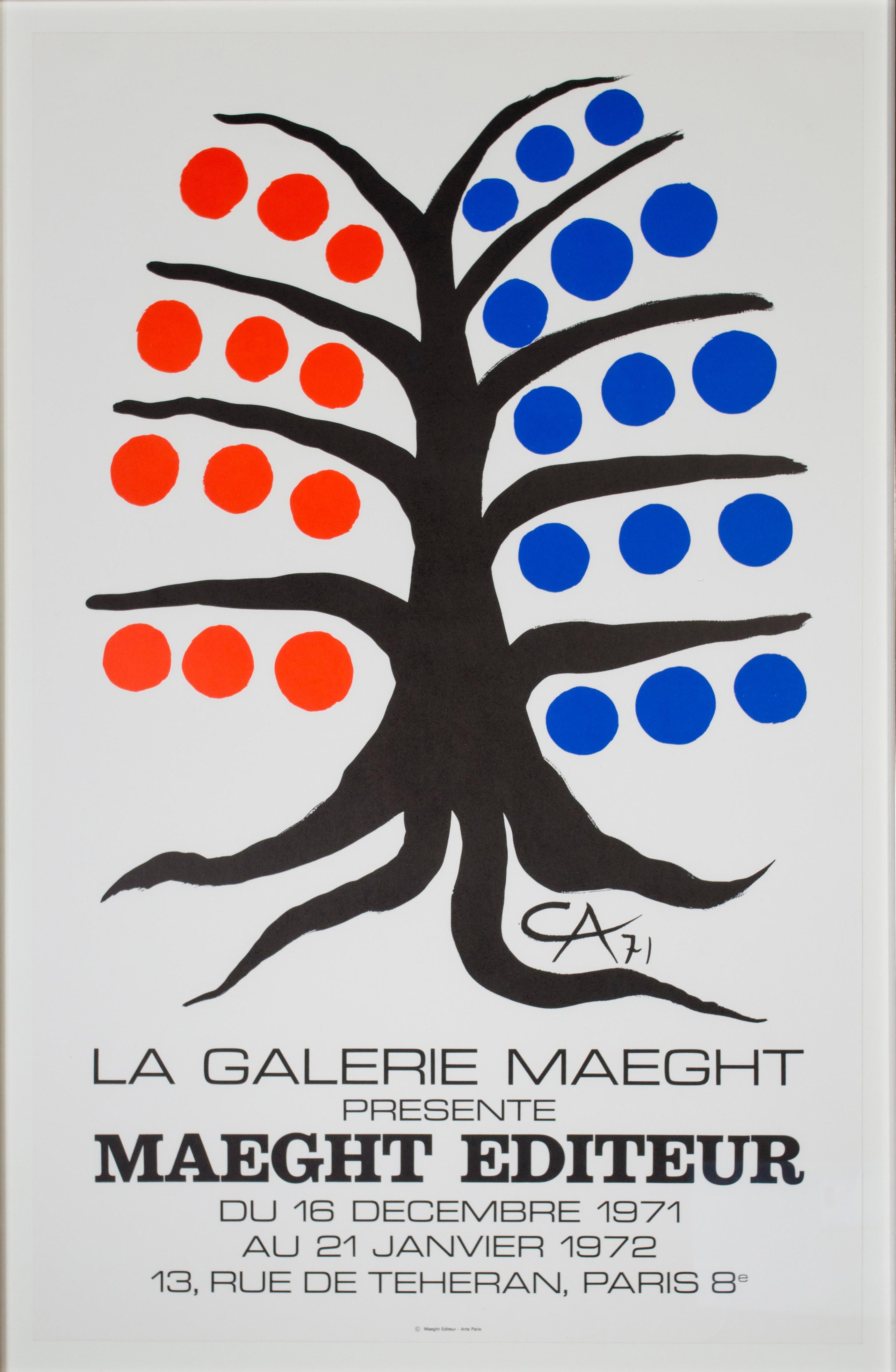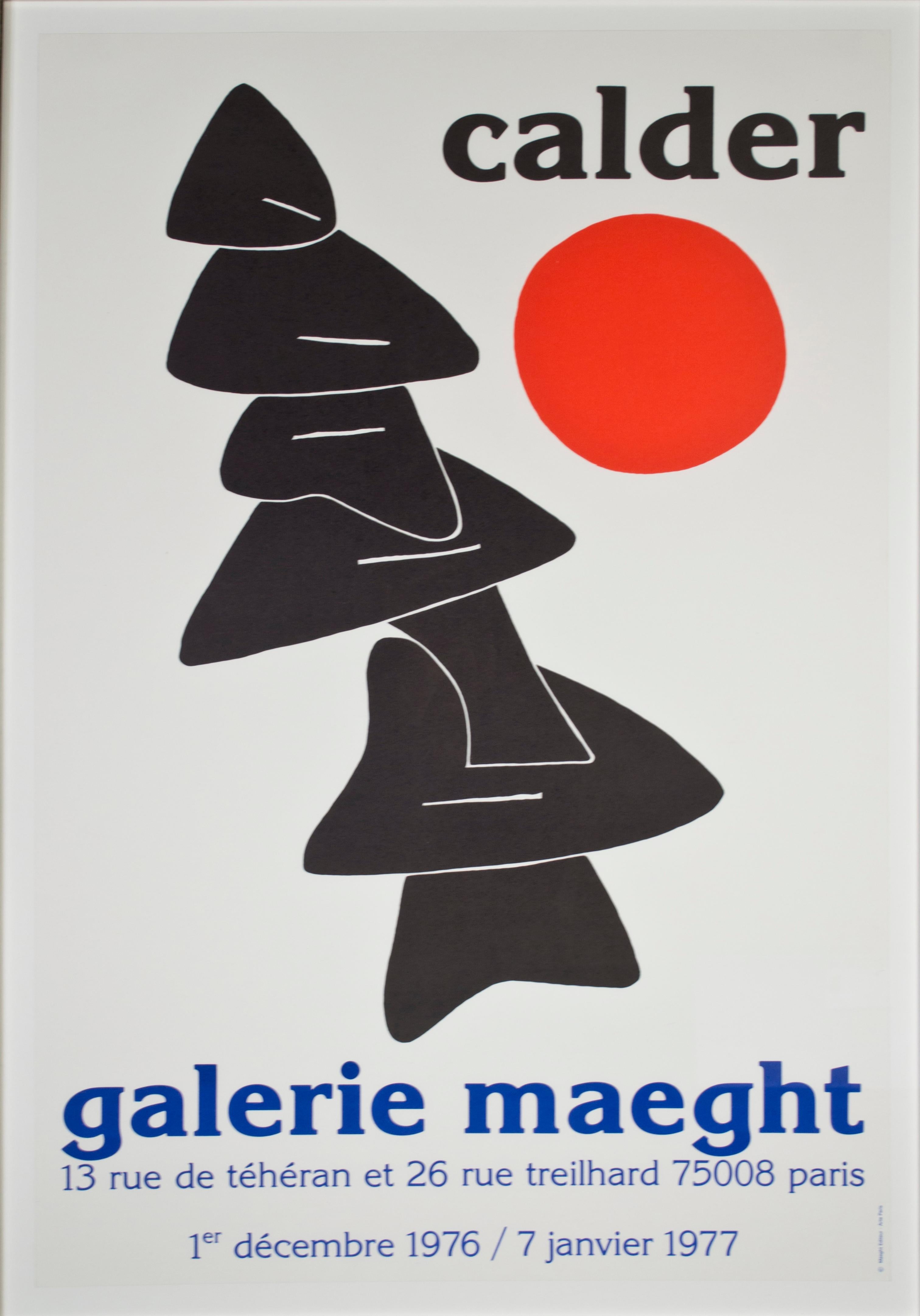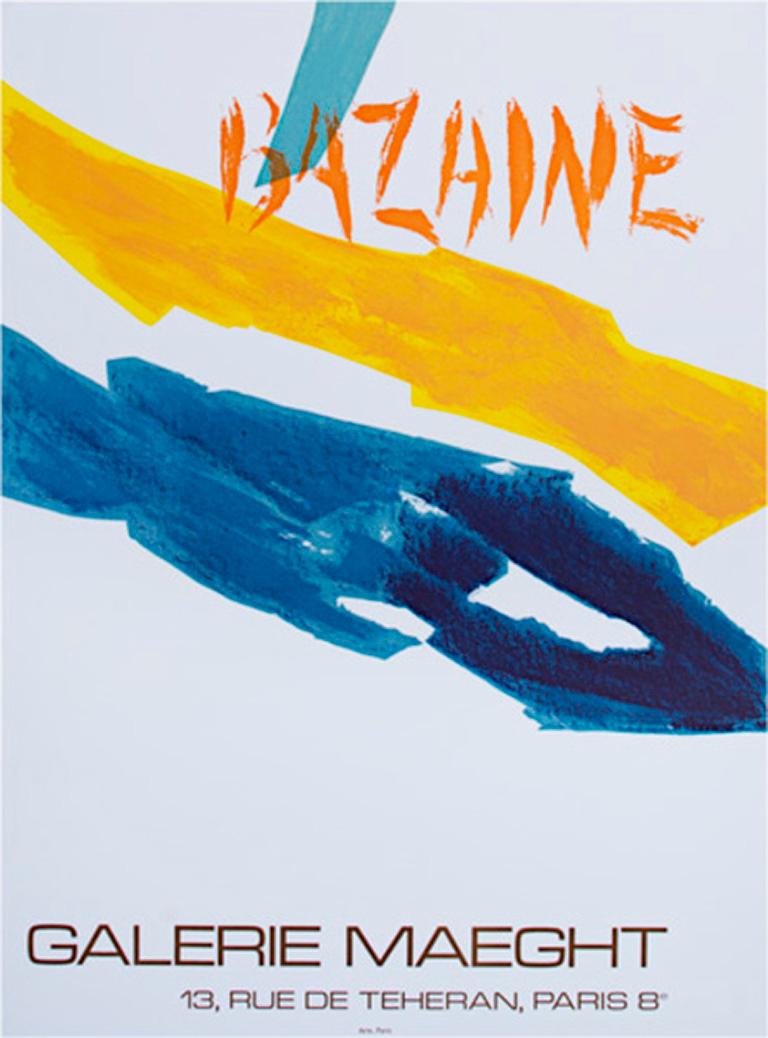Alexander CalderFriendship - Alexander Calder from the Flying Colors Collection Signed in Plate1974
1974
About the Item
- Creator:Alexander Calder (1898 - 1976, American)
- Creation Year:1974
- Dimensions:Height: 20 in (50.8 cm)Width: 26 in (66.04 cm)
- More Editions & Sizes:20 x 26 in.Price: $1,750
- Medium:
- Movement & Style:
- Period:
- Condition:
- Gallery Location:Philadelphia, PA
- Reference Number:1stDibs: LU1523214297712
Alexander Calder
The American sculptor Alexander Calder is known as the father of the mobile, a moving artwork composed of delicately balanced sculptural forms suspended from the ceiling.
Because Calder's parents, both artists themselves, did not want him to suffer the hardships of trying to make a living in art, they encouraged the young Calder to study mechanical engineering at the Stevens Institute of Technology, in Hoboken, New Jersey. He worked a number of jobs, including as a hydraulic engineer and draftsman for the New York Edison Company, before deciding to pursue an artistic career. He never abandoned his engineering background, however, applying his understanding of gears and moving parts in all his artworks, from mechanical toys like the Cirque Calder (1931) and his revered prints to his free-standing abstract sculptures, called stabiles.
In 1926, Calder moved to Paris and established a studio in the Montparnasse quarter. He began creating the many parts of his famous miniature circus from found materials, such as wire, string, cloth, rubber and cork. Designed to be transportable, Cirque grew to fill five suitcases over the years. Always interested in putting forms in motion, Calder also pioneered a new art form called wire sculptures, which he described as “drawings in space.” Like his famous mobiles, the wire sculptures were suspended so that they turned with any movement of the air, presenting different forms when viewed from different angles.
In the 1950s, Calder returned to his roots in mechanical engineering, creating monumental abstract sculptures that verged on the architectural. He worked from loose gestural drawings like this preparatory sketch for his Man Stabile, from 1966. Throughout his career, he also worked as a set designer for the theater, as well as an illustrator and printmaker, producing vibrant, whimsical drawings for books and journals.
Find original Alexander Calder art today on 1stDibs.
- ShippingRetrieving quote...Ships From: Philadelphia, PA
- Return PolicyA return for this item may be initiated within 7 days of delivery.
- Bestie - Alexander Calder Mint Condition from Flying Colors CollectionBy Alexander CalderLocated in Philadelphia, PAArtist: Alexander Calder Title: Beastie Year: 1974 Dimensions: 20in. by 26in. Edition: From the rare limited edition Suite: The Flying Colors Collection Medium: Original lithograph o...Category
21st Century and Contemporary Post-Modern Prints and Multiples
MaterialsLithograph
- Roy Lichtenstein Haystack #1, 1969 Hand Signed Pop Screenprint & LithographBy Roy LichtensteinLocated in Philadelphia, PAHaystack #1, 1969 Lithograph and screenprint on Rives BFK paper Signed, dated and numbered in pencil Publisher: Gemini G.E.L., Los Angeles Literature: Corlett 65Category
Late 20th Century Pop Art Prints and Multiples
MaterialsLithograph, Screen
- Reflections on MinervaBy Roy LichtensteinLocated in Philadelphia, PARoy Lichtenstein Reflections on Minerva 1990 Lithograph, screenprint, relief, and metalized PVC collage with embossing on mold-made Somerset paper Signed, numbered, and dated in pen...Category
1990s Pop Art More Prints
MaterialsLithograph, Screen
- Untitled from URGE (Powder Blue)By KAWSLocated in Philadelphia, PAKAWS Untitled from Urge (Powder Blue) From the rare limited edition of 250 Original Silkscreen on paper Hand signed and numbered MINT ConditionCategory
2010s Prints and Multiples
MaterialsScreen, Lithograph
- Untitled from URGE (Dark Red) Signed Original Screen PrintBy KAWSLocated in Philadelphia, PAKAWS Untitled from Urge (Dark Red) From the rare limited edition of 250 Original Screen print on paper Hand signed and numbered MINT ConditionCategory
2010s Prints and Multiples
MaterialsScreen, Lithograph
- ThistleBy Donald BaechlerLocated in Philadelphia, PAARTIST: Donald Baechler TITLE: Thistle MEDIUM: Original Lithograph in Colors on Paper SIZE: 45 in x 22 in EDITION: ...Category
1990s Prints and Multiples
MaterialsLithograph
- Architectural StudyBy Ettore SottsassLocated in Greding, DELarge format lithograph with architectural study, partly coloured. Signed at lower right. Edition 65/100(?).Category
Late 20th Century Post-Modern Landscape Prints
MaterialsLithograph
- "Maeght Editeur, " Original Color Lithograph Poster signed by Alexander CalderBy Alexander CalderLocated in Milwaukee, WI"Maeght Editeur" is an original color lithograph poster signed by Alexander Calder. This poster was for an exhibit on Alexander Calder's work in Paris, France. It depicts a black tre...Category
1970s Post-Modern Landscape Prints
MaterialsLithograph
- "Stabile with Red Sun Galerie Maeght, " Original Lithograph Poster by A. CalderBy Alexander CalderLocated in Milwaukee, WI"Stabile with Red Sun Galerie Maught" is an original color lithograph by Alexander Calder. The Stabile is a black topsy-turvy statue taking up most of the piece. A red sun sits to th...Category
1970s Post-Modern Abstract Prints
MaterialsLithograph
- "Galerie Maeght, " Graphic Color Lines Lithograph Poster by Jean Rene BazaineLocated in Milwaukee, WI"Galerie Maeght" lithograph poster by Jean Rene Bazaine. This poster holds Bazine's name in harsh orange lines near the top of the piece. Diagonally bisecting the b and a in Bazaine is a teal line. Bellow this horizontally against the white backgrounds are two lines, one painted yellow and the other blue. Image: 29 x 21 in Jean Bazaine was a French painter, designer of stained glass windows, and writer. He was the great great grandson of the English Court portraitist Sir George Hayter. In 1949/1950 he had his first major one man show at the Galerie Maeght, who remained his art dealer thenceforth. From then on it was a steady progress of major exhibitions: Bern, Hanover, Zürich, Oslo... 1987 a retrospective exhibition in Galerie Maeght, 1988 a retrospective of his drawings in the Musée Matisse and finally in 1990 the Exposition Bazaine in the Galeries Nationales du Grand Palais, Paris., which was accompanied by the reissue of his major texts on painting in art theory as Le temps de la peinture (Paris, Aubier 1990). "The motley crowds of international tourists and souvenir-shoppers who fill the ancient streets of the Latin Quarter in Paris spend most of their time admiring the open-air displays of seafood outside the Greek restaurants in the rue de la Huchette. They ignore the beautiful church of St Severin in the same street, for have they not already "done" Notre Dame? So they miss one of the most wonderful series of stained-glass windows in France: Jean Bazaine's vivid, dynamic works irradiating the sombre ambulatory and apsidal chapels. These windows represent the seven sacraments of the Church, portrayed as essential forms from nature in all its glory and symbolising Water, Fire and Light, sacred emblems of Divine Grace. An appropriate biblical verse is inscribed beneath each. Only Pierre Soulages with his "luminous black" windows at l'Abbaye de Conques (1998) can stand comparison with the majesty of these contemporary works by Bazaine, created between 1965 and 1970. Bazaine was fortunate in his friends. He received at an early stage in his student career support and advice from another master colourist, Pierre Bonnard. In his youth he knew Leger, Braque, James Joyce and Marcel Proust. One of his great personal friends was Jean Fautrier, with whom he shared his first exhibition in 1930. His work gradually developed as a form of bold tachisme - brilliantly composed but well-controlled "splashes" of sumptuous colour. He rejected the term "abstract" which he considered a denial of the essentially intimate relationships between art and reality. He quoted his friend Braque: "The canvas must efface the idea behind it." In 1941, during the Nazi occupation, at a time when Hitler was destroying many works of modern art, Bazaine had the courage to organise in Paris a first "avant-garde" exhibition of 20 French artists. In 1948, he wrote his first book, an unpedantic, unacademic view of contemporary painting, Notes sur la peinture d'aujourd'hui. He quotes Braque on Cezanne: "He's a painters' painter - other people think it's unfinished." Bazaine, too, reverenced Cezanne: Three lines drawn by Cezanne overturn our whole concept of the world, proclaim the liberty of man, his courage. The great painters have never had any other aims. The painter says: "I exist, therefore you exist. I am free, therefore you are free. Or at least he tries to. It's his one aim in life." After the Second World War, Bazaine produced vast compositions with virtuoso colour structures, mostly with references to nature, like the breathtaking Vent de mer (1949, now in the Museum of Modern Art, Paris) and Orage au jardin (1952, now in the Van Abbemuseum at Eindhoven). His Earth and Sky (1950) is in the Maeght Foundation at Saint Paul de Vence. One of his greatest works, L'Arbre tenebreux (1962), was sold to the Sonja Henie...Category
1970s Post-Modern Abstract Prints
MaterialsLithograph
- Plant and Lamp (B+Y; Y+B)By John BaldessariLocated in New York, NYIn order to subvert common associations, Baldessari calls one’s attention to minute details, absurd juxtapositions, and obscured or fragmented portions of imagery.Category
1990s Post-Modern Still-life Prints
MaterialsLithograph
- The Talmudists Post Soviet Non Conformist Avant Garde Judaica LithographBy Alek RapoportLocated in Surfside, FLDimensions w/Frame: 18.5 X 14.5 Alek Rapoport (November 24, 1933, Kharkiv, Ukraine SSR – February 4, 1997, San Francisco) was a Russian Nonconformist artist, art theorist and teacher. Alek Rapoport spent his childhood in Kiev (Ukraine SSR). During Stalin's "purges" both his parents were arrested. His father was shot and his mother spent ten years in a Siberian labor camp. Rapoport lived with his aunt. At the beginning of World War II, he was evacuated to the city of Ufa (the Bashkir Autonomous Soviet Socialist Republic). A time of extreme loneliness, cold, hunger and deprivation, this period also marked the beginning of Rapoport's drawing studies. After the war, Rapoport lived in Chernovtsy (Western Ukraine), a city with a certain European flair. At the local House of Folk Arts, he found his first art teacher, E.Sagaidachny (1886–1961), a former member of the nonconformist artist groups Union of the Youth (Soyuz Molodyozhi) and Donkey's Tail, popular during the 1910s–1920s. His other art teacher was I. Beklemisheva (1903–1988). Impressed by Rapoport's talent, she later (1950) organized his move to Leningrad, where he entered the famous V.Serov School of Art (the former School of the Imperial Society for the Promotion of Arts, OPKh, later the Tavricheskaya Art School). His association with this school lasted eight years, first as a student, and then, from 1965 to 1968, as a teacher. With "Socialist realism" the only official style during this time, most of the art school's faculty had to conceal any prior involvement in non-conformist art movements. Ya.K.Shablovsky, V.M.Sudakov, A.A.Gromov introduced their students to Constructivism only through clandestine means. (1959–1963) Rapoport studied stage design at the Leningrad Institute of Theater, Music and Cinema under the supervision of the famous artist and stage director N.P.Akimov. Akimov taught a unique course based on theories of Russian Suprematism and Constructivism, while encouraging his graduate students to apply their knowledge to every field of art design. Despite differences in personal artistic taste with Akimov, who was drawn to Vermeer and Dalí, Rapoport was influenced by Akimov's personality and liberalism, as well as the logical style of his art. In 1963, Rapoport graduated from the institute. His highly acclaimed MFA work involved the stage and costume design for I.Babel's play Sunset. In preparation, he traveled to the southwest regions of the Soviet Union, where he accumulated many objects of Judaic iconography from former ghettos, disappearing synagogues and old cemeteries. He wandered Odessa in search of Babel's characters and the atmosphere of his books. He organized a new liberal course in technical aesthetics, introducing his students to Lotman's theory of semiotics, the Modulor of Le Corbusier, the Bauhaus school, Russian Constructivism, Russian icons and contemporary Western art. As a result of his "radicalism," Rapoport was fired for "ideological conspiracy." He sought to cultivate himself as Jewish artist. This became particularly noticeable after the Six-Day War, when the Israeli victory led intellectuals, including the Jewish intelligentsia, to feel a heightened interest in Jewish culture and its Biblical roots. Rapoport's works of this period include Three Figures, a series of images of Talmudic Scholars, and works dealing with anti-Semitism. In the 1970s Rapoport joined the non-conformist movement, which opposed the dogmas of "Socialist realism" in art, along with Soviet censorship. The movement sought to preserve the traditions of Russian iconography...Category
1970s Post-Modern Figurative Prints
MaterialsLithograph
Recently Viewed
View AllRead More
Renowned for His Mobiles, Alexander Calder Was Also Adept at Crafting Modernist Jewelry
There are no sparkling gemstones on this necklace, but its value far exceeds the cost of its materials.
10 Must-Visit American Public Sculptures
Get your dose of Vitamin D while surveying works by the likes of Alexander Calder, Keith Haring and Pablo Picasso.





